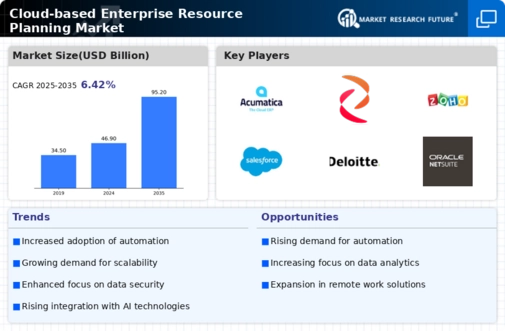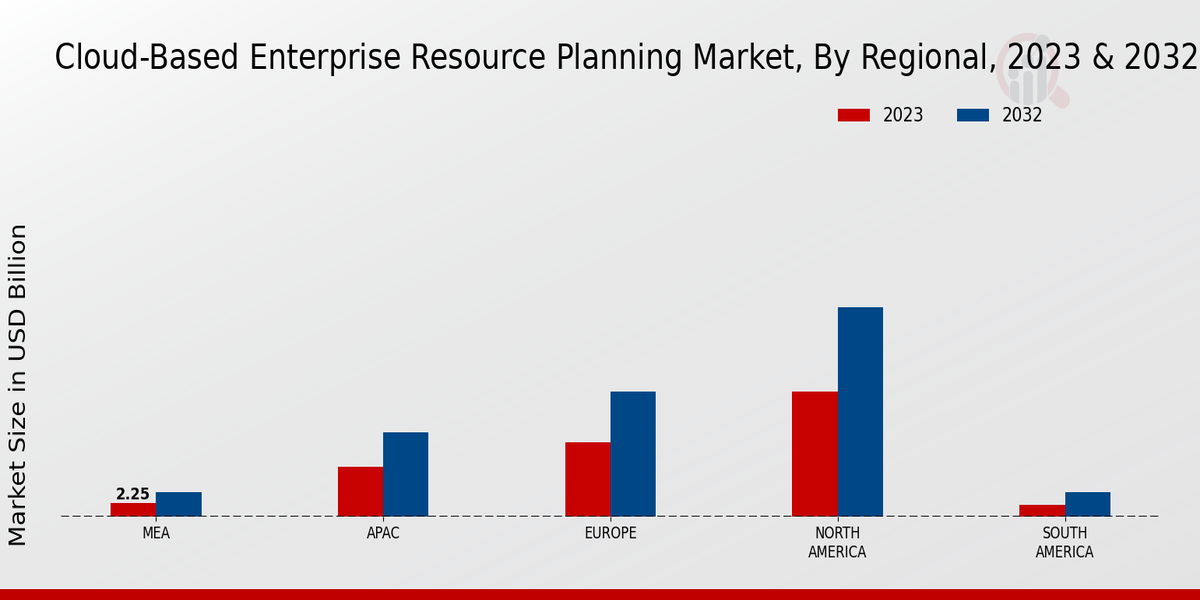Market Growth Projections
The Global Cloud-based Enterprise Resource Planning Market Industry is projected to experience robust growth over the next decade. With a market value of 46.9 USD Billion in 2024, it is anticipated to reach 95.2 USD Billion by 2035. This growth trajectory indicates a compound annual growth rate of 6.66% from 2025 to 2035. The increasing adoption of cloud solutions across various sectors, coupled with advancements in technology, is likely to drive this expansion. Organizations are expected to invest in cloud-based ERP systems to enhance efficiency, streamline operations, and improve overall business performance.
Rising Need for Real-time Analytics
The Global Cloud-based Enterprise Resource Planning Market Industry is propelled by the rising need for real-time analytics. Businesses are increasingly recognizing the importance of data-driven decision-making, which necessitates access to up-to-date information. Cloud-based ERP systems provide organizations with the ability to analyze data in real-time, enabling them to respond swiftly to market changes and customer demands. This capability is particularly beneficial in industries such as finance and logistics, where timely insights can lead to improved operational efficiency. As the demand for real-time analytics continues to grow, the market is poised for substantial expansion.
Integration of Advanced Technologies
The Global Cloud-based Enterprise Resource Planning Market Industry is being transformed by the integration of advanced technologies such as artificial intelligence and machine learning. These technologies enhance the capabilities of cloud-based ERP systems, enabling predictive analytics and automation of routine tasks. As businesses seek to leverage data for strategic decision-making, the incorporation of these technologies becomes increasingly vital. The market is expected to grow at a CAGR of 6.66% from 2025 to 2035, reflecting the potential of these innovations to drive efficiency and improve operational performance. Companies that adopt these advanced solutions are likely to gain a competitive edge in their respective industries.
Enhanced Data Security and Compliance
The Global Cloud-based Enterprise Resource Planning Market Industry is witnessing a heightened focus on data security and compliance. As organizations increasingly store sensitive information in the cloud, the demand for secure ERP solutions is paramount. Cloud providers are investing in advanced security measures, such as encryption and multi-factor authentication, to protect data from breaches. Additionally, compliance with regulations such as GDPR and HIPAA is driving businesses to adopt cloud-based ERP systems that offer built-in compliance features. This emphasis on security not only protects organizations but also builds trust with customers, further propelling the growth of the market.
Increased Adoption of Cloud Solutions
The Global Cloud-based Enterprise Resource Planning Market Industry experiences a surge in adoption as organizations seek to enhance operational efficiency and reduce costs. In 2024, the market is projected to reach 46.9 USD Billion, driven by the need for scalable solutions that can adapt to changing business environments. Companies are increasingly migrating from traditional on-premises systems to cloud-based platforms, which offer flexibility and accessibility. This transition is particularly evident in sectors such as manufacturing and retail, where real-time data access is crucial for decision-making. As businesses recognize the advantages of cloud solutions, the market is expected to grow significantly.
Growing Demand for Remote Work Solutions
The Global Cloud-based Enterprise Resource Planning Market Industry is influenced by the rising demand for remote work solutions. Organizations are increasingly adopting cloud-based ERP systems to facilitate collaboration among distributed teams. These systems enable employees to access critical business information from anywhere, promoting productivity and engagement. As remote work becomes a permanent fixture in many industries, the need for robust cloud solutions is likely to escalate. This trend is reflected in the projected market growth, with expectations of reaching 95.2 USD Billion by 2035. The ability to integrate various business functions into a single platform further enhances the appeal of cloud-based ERP systems.















